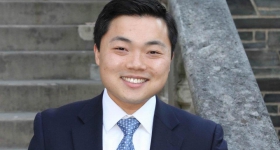PROJECT EM
While they may not share her curves, the 20 "brothers" of the San Francisco Bay Area's Project EM do put Beyonce's signature sass to shame.
What began in 2007 as a side project of Emerson Aquino, executive art director of Funkanometry SF, has evolved into a formidable force in today's dance world. In a sea of cookiecutter coed dance teams, this all-male troupe breaks out of the "tough guy" stereotype with highly stylized routines and a "grown and sexy, masculine but edgy" image. Where else can you find a group of males with the chemistry necessary to pull off the fierce sexiness required of Britney Spears, and seconds later, channel King Tut to a song from a video game soundtrack?
The secret: "brotherhood and acceptance," according to member Long Trinh.
The secret also seems to include a seeming lack of stagehog syndrome. Competition runs rampant within most dance teams but Jomar Monzén, one of 12 original members, stresses that in Project EM, 'there is no single superstar."
With choreography ranging from intricate and precise to slinky and soulful, the dancers communicate constantly both in and out of practice - to stay on beat. Having spent countless hours, week after week, studying each other's movements, a teammate's compliment or critique is held in high esteem.
Many of the company's performers hail from other dance teams and note the difference. "I have danced with other entities in the dance world, but none can compare to what I have experienced with these talented men," Sal Urena said of his three months with Project EM.
And while most teams stick to club and competition performances, Project EM is no stranger to members' family functions - yes, they even do weddings.
Project EMs routines evoke a grown and sexy, masculine but edgy image.
Lords of the dance: Project EM members (from eft) Dave Le, JP Reyes, Emerson Aquino, Eric Andres and Sammy Ramirez (back).
THE BRISENO FAMILV
In 2003, Filipino American couple Joseph and Eva Marie Briseno received the phone call that every soldier's parents dread. Their 20-year-old son, Joseph Jr., or Jay, had been on a routine mission in Baghdad when he was shot, pointblank, in the back of the neck. Jay miraculously survived but was in a deep coma.
At the hospital he was transferred to in Germany, Jay was barely recognizable to his family: His mouth was a maze of tubes and his wounds were still bleeding. Jay's spinal cord had been severed, resulting in severe paralysis from the neck down. Jay had loved to dance; now he was suddenly unable to perform basic functions, like eating and breathing, without assistance. The Brésenos were advised to start planning funeral services.
Though death seemed imminent, days turned into months, and months into years. Today, Joseph and Eva Marie serve as Jay's primary caregivers, after years of failed attempts at finding a qualified nurse. "Home health agencies couldn't support our family's needs," Joseph said. He and his wife, with the support of the Department of Veterans Affairs, are planning to open their own home care agency this year.
Jay requires round-the-clock care. A typical day begins at 5:30 a.m. with the hourlong process of using the restroom. Since Jay cannot cough, his parents massage his chest and administer medication to remove pneumoniacausing mucous. Jay then eats lunch, which he consumes through a tube, and indulges in his favorite show, American Idol.
Jay uses a specialized cycling bike to exercise his limbs and takes medication throughout the day. Around 5:30 p.m., his parents prepare Jay for bed. Though lights are out by 9 p.m., they monitor him throughout his sleep, turning Jay every so often to make sure he is comfortable. And they continue to hope a cure is discovered for Jay.
THE YEN FAMILY
The collision of religion and ethnicity often makes up the formula by which people define their identities. As Chinese American Mormons, newlyweds Bobby and Jasmine Yen balance their ethnic culture with the rules of a church that is predominantly white.
The Yens come from a Mormon community in Southern California with a substantial Chinese following. Both sets of their parents and grandparents set roots in the church in the 1950s. "The sight of two young Caucasian men who could speak Mandarin Chinese was quite intriguing," Bobby said, describing his grandmother's first encounter with Mormon missionaries in Taiwan.
Like most Mormon children, the Yens underwent their own personal conversion experiences when they were 8. Jasmine recalled an instance from childhood when a Chinese boy, who attended a neighboring, non-Mormon church, called her Muslim. When she politely corrected him, he replied that there was no difference between the two religions - both were wrong.
Although Mormonism specifically prohibits the consumption of tea, a staple in Chinese culture, both Mormon and Chinese cultures do place special emphasis on the importance of strong family bonds; in fact, Jasmine noted that Mormonism has reinforced her respect for her elders. Moreover, Mormonism's concept of "eternal families," the idea that families last forever, is not too different from the Chinese tradition of honoring family ancestors.
But for the Yens, the church was by and large a place of cultural exchange. As a kid, Bobby learned about camping and the art of Laser Tag from his white church friends; from him, they learned about Chinese New Year and tasted Chinese cuisine. Does his experience as a Chinese American Mormon differ from those of white Mormons? "Of course," Bobby replied, "but our differences come after religion."
PI ALPHA PHI
The bloodline connecting the members of Pi Alpha Phi may be artificial but the brotherhood fostered between members most certainly is not.
With an extended family of at least 3,000 current and alumni brothers spanning 13 chapters nationwide, the members of Pi Alpha Phi work to continue the legacy started in 1929 when six Chinese American men, banned from on-campus housing and fraternity membership at the University of California, Berkeley, decided to start their own fraternity to foster brotherhood and education between Chinese men. The fraternity today strives to promote not only brotherhood and academic excellence among members, but also a sense of philanthropy, leadership and Asian American awareness.
In recent years, however, the dangerous hazing rituals of Asian fraternities at some campuses, including the University of California, Irvine, Northwestern University and the University of Texas, Austin, have overshadowed these efforts. Some incidents, like the UC Irvine pledge football game in which players wore no helmets or padding, have resulted in the deaths of pledges or frat members.
"It is difficult to rise above [the notoriety] because the Asian Greeks are often viewed by outsiders as collective," said Douglas Radtke, Pi Alpha Phi's national membership development and education chair. "So when one organization has a pledge die or something catastrophic happen, we're all bundled together." Pi Alpha Phi may do its fair share of partying, but it does not have any record of deaths due to its pledging process.
To address growing hostility toward Asian Greeks due to these incidents, Pi Alpha Phi has joined forces with other Asian fraternities and sororities under the National Asian Pacific Islander American Panhellenic Association. The coalition, which organized a tsunami relief fund and a campaign to encourage voting in the Asian American community, is currently attempting to counter the unflattering image painted by recent media.
Band of brothers: Pi Alpha Phi members at UC Irvine. The fraternity promotes brotherhood, academic excellence, philanthropy, leadership and Asian American awareness among its members.
THE SUTTER FAMILY
"Everything I know from growing up is concealed by the way I look," said Eric Sutter, who is 100 percent white and was adopted as a newborn by Sandy Sutter - who is 100 percent Chinese.
Sandy made it a priority to instill knowledge of Chinese cultural tradition in both Eric and his brother, Tyler, who is her biological hapa son and describes himself as "the manifestation of the melting pot." Growing up, the brothers spent afternoons shopping, eating and socializing with their grandparents in San Francisco's Chinatown. At home, they ate casseroles and fried rice for dinner; at bedtime, the ancient Chinese legend of the Monkey King and the classic American stories of Dr. Seuss took turns lulling them to sleep. Yet Eric says he is still handed a fork and a basic menu at most Chinese restaurants.
As a child, Eric would often get into fights when kids asked him why he didn't look like his mom. "A lot of kids just don't know how to deal with things that don't immediately make sense," he said.
Sandy describes her approach to parenting as largely unconscious of the racial differences between her sons. "I would have raised my sons the same way if they had all been Chinese," she said.
Likewise, Tyler defines family as "a mindset," regardless of biological ties. "Family is the people who love you regardless of who or what you are," Tyler said.
All different, all the same: Eric Sutter, left, was adopted as a newborn by Sandy Sutter. Tyler, right, is Sandy's biological hapa son.
THE LIM FAMILY
It's 8 p.m. and the soothing baritone of Gregorian chants wafts through Alicia Lim's bedroom. Surrounded by the 13-month-old's toys, new parents Amos and Mickey Lim savor the post-bedtime tranquility in their cozy San Francisco home. In the midst of such easy warmth, it's hard to imagine the struggles Mickey and Amos endured to build their family.
Their romance began online 13 years ago; Mickey lived in the United States, Amos in Singapore. For four years, they maintained a trans-Pacific relationship, relying on the Internet and mail. In order to be with Mickey in the United States, Amos enrolled in a yearlong MBA program that, upon completion, would place him with a company that would sponsor his work visa.
But after the 9/11 terrorist attacks, the company claimed not to have the resources to go ahead with Amos' visa. Without it, Amos would have to leave the country. The long awaited adoption was put on hold indefinitely.
Determined not to be separated again, Mickey decided that should Amos be forced to leave the country, he would follow. But for him, it was no easy choice between the person and the country he loved. "It's unfair that [the government] would force me to leave the country I served," said Mickey, a veteran of the Air Force who served in the 1980s, when it was illegal to be gay in the military.
Fortunately, Amos obtained a green card through new employment, which was more of a "green light" to the couple's happiness.
The most recent piece of the Lim family puzzle was placed last summer. The couple had long wanted to adopt and after two years of navigating the foster system and volumes of paperwork, Mickey and Amos met Alicia, who is white. After just 15 minutes, she was fast asleep in their arms. The trio remains a testament to the adage that where there's a will, there will always be a way.
Three's company: Mickey, top, and Amos Lim spent years apart before Amos could immigrate to the United States. Baby Alicia completed their family.
Adrienne Aguirre is a writer living in San Francisco.








Comments